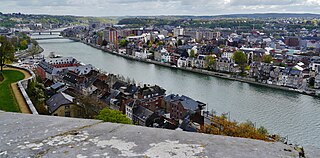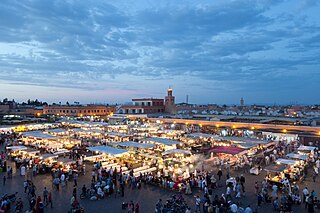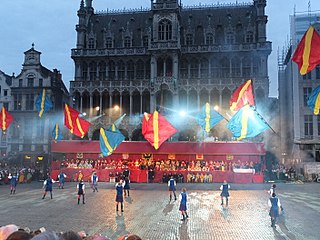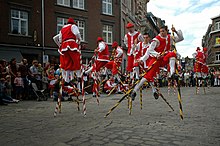
Wallonia, officially the Walloon Region, is one of the three regions of Belgium—along with Flanders and Brussels. Covering the southern portion of the country, Wallonia is primarily French-speaking. It accounts for 55% of Belgium's territory, but only a third of its population. The Walloon Region and the French Community of Belgium, which is the political entity responsible for matters related mainly to culture and education, are independent concepts, because the French Community of Belgium encompasses both Wallonia and the bilingual Brussels-Capital Region.

Charleroi is a city and a municipality of Wallonia, located in the province of Hainaut, Belgium. The city is situated in the valley of the Sambre, in the south-west of Belgium, not far from border with France. By 1 January 2008, the total population of Charleroi was 201,593. The metropolitan area, including the outer commuter zone, covers an area of 1,462 square kilometres (564 sq mi) with a total population of 522,522 by 1 January 2008, ranking it as the 5th most populous in Belgium after Brussels, Antwerp, Liège, and Ghent. The inhabitants are called Carolorégiens or simply Carolos.

Binche is a city and municipality from Wallonia, in the province of Hainaut, Belgium. Since 1977, the municipality consists of Binche, Bray, Buvrinnes, Épinois, Leval-Trahegnies, Péronnes-lez-Binche, Ressaix, and Waudrez districts.

Namur is a city and municipality in Wallonia, Belgium. It is the capital both of the province of Namur and of Wallonia, hosting the Parliament of Wallonia, the Government of Wallonia and its administration.

Processional giants are costumed figures in European folklore, particularly present in Belgian, French, Portuguese, Spanish, and English folkloric processions. The main feature of these figures is typically their papier maché head, whilst bodies are covered in clothing matching the costume's theme.

In Belgium, the French Community refers to one of the three constituent constitutional linguistic communities. Since 2011, the French Community has used the name Wallonia-Brussels Federation, which is controversial because its name in the Belgian constitution has not changed and because it is seen as a political statement. The name "French Community" refers to Francophone Belgians, and not to French people residing in Belgium. As such, the French Community of Belgium is sometimes rendered in English as "the French-speaking Community of Belgium" for clarity, in analogy to the German-speaking Community of Belgium.

Stilts are poles, posts or pillars that allow a person or structure to stand at a height above the ground.

Jemaa el-Fnaa is a square and market place in Marrakesh's medina quarter. It remains the main square of Marrakesh, used by locals and tourists.

Koutammakou, the Land of the Batammariba is a cultural landscape designated in 2004 as a UNESCO World Heritage Site at the border between northern Togo and Benin. The area features traditional mud tower-houses which remain the preferred style of living. The traditional mud houses are known as a national symbol of Togo. Many of the mud houses have two floors and some of them have a flat roof.

The Carnival of Binche is an annual festival held in Binche, Hainaut, Belgium, during the Sunday, Monday, and Tuesday preceding Ash Wednesday.

Fantasia is a traditional exhibition of horsemanship in the Maghreb performed during cultural festivals and for Maghrebi wedding celebrations. It is present in Algeria, Libya, Mali, Mauritania, Morocco, Niger and Tunisia. It is attested in the ancient Numidian times during which it was practiced by the Numidian cavalry. Historian Carlos Henriques Pereira stated that the North African fantasia also called barud is a modern watered down version of a Numidian military technique.
The history of Wallonia, from prehistoric times to the present day, is that of a territory which, since 1970, has approximately coincided with the territory of Wallonia, a federated component of Belgium, which also includes the smaller German-speaking Community of Belgium. Wallonia is the name colloquially given to the Walloon Region. The French word Wallonie comes from the term Wallon, itself coming from Walh. Walh is a very old Germanic word used to refer to a speaker of Celtic or Latin.

The Ommegang of Brussels is a traditional Ommegang, a type of medieval pageant, celebrated annually in Brussels, Belgium.
Guy Van Waas is a Belgian conductor, clarinetist and organist.
The Choeur de Chambre de Namur is a choir based in Namur, which is sponsored by the Communauté française de Belgique. Since 2010 the artistic director has been Leonardo García Alarcón and conductor of the instrumental ensemble is Guy Van Waas.

Mangal Shobhajatra or Mongol Shovajatra is a mass procession that takes place at dawn on the first day of the Bengali New Year in Bangladesh. The procession is organised by the teachers and students of the Faculty of Fine Arts of the University of Dhaka. The festival is considered an expression of the secular identity of the Bangladeshi people and as a way to promote unity. It was declared an intangible cultural heritage by UNESCO in 2016, categorised on the representative list as a heritage of humanity.

The Ducasse d'Ath is a traditional parade held to mark the victory of David over Goliath that takes place in the town of Ath in Belgium.

The chedda of Tlemcen is a traditional Algerian dress, more precisely of the city of Tlemcen, but also worn in the west of the country, in particular in Oran and Mostaganem. A product of the local craftsmanship, it is worn by brides in Tlemcen for their wedding ceremony.

Sebiba is the term used in Algeria to designate a festival and the Tuareg people's dance performed on this occasion and accompanied by female drummers in the Sahara oasis of Djanet in the Tassili n'Ajjer region in southern Algeria. The dance originated among the descendants of black African slaves and is part of the celebrations for the Islamic Ashura Festival. The dance was recognized by UNESCO in 2014 for its significance to humanity's intangible cultural heritage.
Cultural expressions are creative manifestations of the cultural identities of their authors. They are treated in the international legal system in terms of cultural rights, intellectual property law and international trade.

















